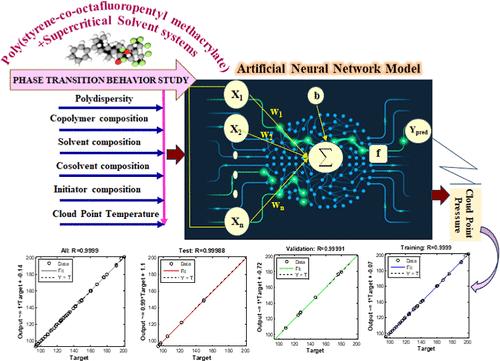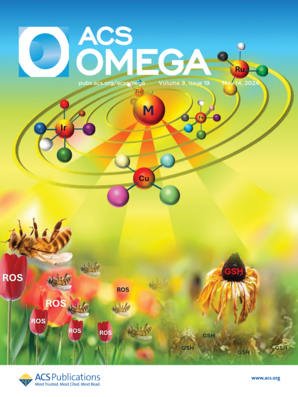共聚物在超临界二氧化碳和有机溶剂中的溶解度行为评估:神经网络预测与统计分析
IF 3.7
3区 化学
Q2 CHEMISTRY, MULTIDISCIPLINARY
引用次数: 0
摘要
在工业领域,了解嵌段共聚物在超临界溶剂中的行为至关重要。虽然在许多情况下使用复杂的理论模型对聚合物溶解度曲线的定性一致性进行了评估,但定量预测仍然具有挑战性。本研究旨在建立一个快速、准确的人工神经网络(ANN)模型,以预测非典型嵌段聚合物聚(苯乙烯-甲基丙烯酸共八氟戊酯)(PSOM)在不同超临界溶剂体系中的下临界溶解度和上临界溶解度空间,预测温度范围(51.75-182.05 ℃)和压力范围(3.28-200.86 兆帕)。本研究使用的实验数据集包括一种共聚物、五种超临界溶剂、一种共溶剂和一种引发剂。它包括七种独特的共聚物-溶剂组合(252 个浊点压力),用于对模型进行定量和定性预测。为了预测 PSOM 与溶剂的相互作用,研究考虑了两种不同的输入系统:六变量系统、五变量系统和一个目标输出。最初,我们使用三层前馈神经网络,从 14 种不同算法中选择最佳学习算法(Levenberg-Marquardt),并考虑了一个 PSOM 溶剂系统样本。然后,通过将所有七个 PSOM 溶剂组合系统的隐藏神经元数量从 2 个到 80 个不等,对网络拓扑结构进行了优化。预测的浊点压力与实验浊点压力非常吻合,证实了模型的准确性。在所有数据集的训练、验证和测试过程中,均方误差最小(≤1.90 × 10-27),线性回归 R2 最大(≥0.99)。此外,还通过统计分析测试了 ANN 模型的准确性,证实该模型能够准确捕捉聚合物的混溶区域,从而实现各种聚合物材料的高效加工。这种数据驱动方法有助于预测其他聚合物和复杂高分子系统的共存曲线。本文章由计算机程序翻译,如有差异,请以英文原文为准。

Assessment of Solubility Behavior of a Copolymer in Supercritical CO2 and Organic Solvents: Neural Network Prediction and Statistical Analysis
In the industrial sector, understanding the behavior of block copolymers in supercritical solvents is crucial. While qualitative agreement with polymer solubility curves has been evaluated using complex theoretical models in many cases, quantitative predictions remain challenging. This study aimed to create a rapid and accurate artificial neural network (ANN) model to predict the lower critical solubility and upper critical solubility space of an atypical block copolymer, poly(styrene-co-octafluoropentyl methacrylate) (PSOM), in different supercritical solvent systems over a wide range of temperatures (51.75–182.05 °C) and high pressure (3.28–200.86 MPa). The experimental data set used in this study included one copolymer, five supercritical solvents, one cosolvent, and one initiator. It consisted of seven unique copolymer–solvent combinations (252 cloud point pressures) used to predict the model quantitatively and qualitatively. To predict the PSOM–solvent interactions, the study considered two different input systems: a six-variable system, a five-variable system, and one target output. Initially, we used a three-layer feed-forward neural network to select the best learning algorithm (Levenberg–Marquardt) from 14 different algorithms, considering one sample PSOM–solvent system. Then, the network topology was optimized by varying hidden neuron numbers from 2 to 80 for all seven PSOM–solvent combination systems. The predicted cloud point pressures were in excellent agreement with the experimental cloud point pressures, confirming the model’s accuracy. It is clear from the results of a minimum mean square error (≤1.90 × 10–27) and maximum linear regression R2 (≥0.99) during training, validation, and testing of all the data sets. Further, the ANN model accuracy was tested by statistical analysis, confirming the model’s ability to accurately capture the miscibility regions of polymers, enabling efficient processing of various polymer materials. This data-driven approach facilitates the prediction of coexistence curves for other polymers and complex macromolecular systems.
求助全文
通过发布文献求助,成功后即可免费获取论文全文。
去求助
来源期刊

ACS Omega
Chemical Engineering-General Chemical Engineering
CiteScore
6.60
自引率
4.90%
发文量
3945
审稿时长
2.4 months
期刊介绍:
ACS Omega is an open-access global publication for scientific articles that describe new findings in chemistry and interfacing areas of science, without any perceived evaluation of immediate impact.
 求助内容:
求助内容: 应助结果提醒方式:
应助结果提醒方式:


